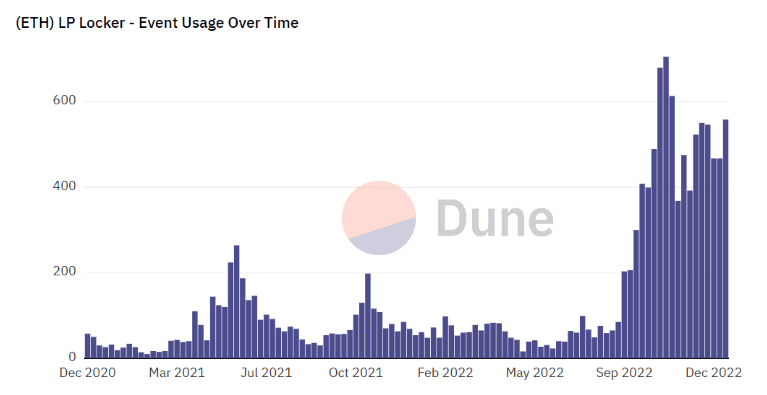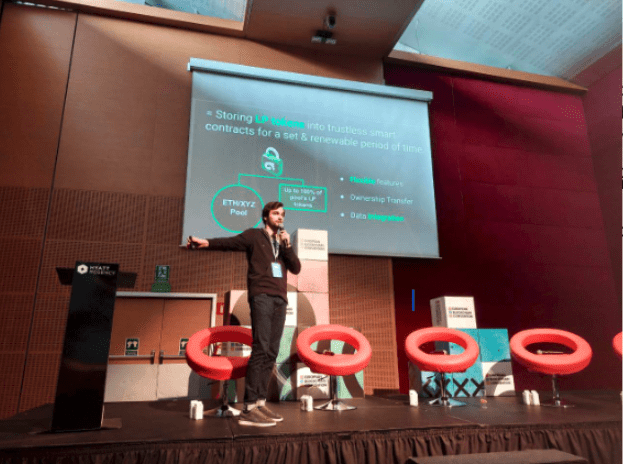Aiming to make the DeFi space more secure, UNCX Network has created and advocated the use of liquidity locking over the past few years at a fervent rate. Having experienced incredible success towards their goal of making this a common practice in the industry, they are now expanding their business to new horizons. With expansion, comes a rebrand and a website upgrade.
Liquidity locker usage over time on the Ethereum chain.
Liquidity locking is when project owners store their liquidity provider tokens into trustless smart contracts for a set & renewable period of time. It essentially removes their ability to unexpectedly withdraw all liquidity and run away with funds. It is a form of malicious DeFi practice (commonly known as “rug-pull” across the industry) prevention.
UNCX first created this tool in mid 2020. Over the last year and especially in the last 6 months, its use has skyrocketed. Investors now growingly expect the projects they invest in to have liquidity provider tokens locked – UNCX predicts that a significant amount of potential scams will be discouraged once the use of liquidity locking becomes complete status quo.
UNCX’s Co-Founder “Chav” at the European Blockchain Convention.
UNCX Network has not stopped at locking, it rather continues to build and develop services with an emphasis on security. The platform includes an on-chain automated launchpad, token vesting, staking & farming as a service and an incoming new minter with innovative and creative capabilities. While the team is not yet ready to disclose the other services and projects they have been silently building, it is a known fact that the 7th version of their platform is just a few months away.
The new website and sleek brand are a reflection of the growth they are experiencing and the new projects they plan to deliver on the market.
Check out their new website here: https://uncx.network
You can find a more in depth explanation of what liquidity locking is here: https://medium.com/@unicrypt/liquidity-locking-overview-112329ecfaaa
What is Liquidity Locking?
Liquidity locking involves storing liquidity provider (LP) tokens in smart contracts for a pre-determined amount of time (locking/unlocking date). These smart contracts are called liquidity lockers. When developers add tokens to liquidity pools, they receive LP tokens representing the liquidity provided in the form of new tokens. Developers can at any time use the LP tokens to withdraw liquidity.
Liquidity lockers allow developers to preemptively lock away a set % of liquidity upon token launch for a specific period of time of their choosing. This prevents instant rugging upon launch (prevents them from being able to withdraw all project liquidity and disappear with it). It’s an approach that ensures developers don’t have control of users’ funds.
The point is simple — When an investor sees that a majority of the project’s liquidity is locked (whether presale stage or afterwards), they feel safer purchasing the token. This also encourages investors to purchase larger shares of the projects’ tokens.
Can I Create My Own Locks?
Some developers may lock tokens in their own self-created time-lock smart contracts. However, creating your own personal liquidity locker contract is not widely accepted because these cannot be trusted. If you are the owner of the locker holding your project’s token, you can easily manipulate the contract and withdraw the funds. Therefore, it’s much more credible to involve 3rd party platforms like the most trusted lockers in the industry; UniCrypt’s.
The whole idea of liquidity locking was conceptualized by UniCrypt and actualized in June 2020. More on why our locking tech is the industry standard and known as the most trustworthy here (insert prev medium article link).
UniCrypt Locker Features:
Lock Splitting: Split your lock and create multiple sub-locks — For example, 100% of liquidity can be locked however if say 10% needs to be withdrawn at any given date, the lock can be split into two, where 90% remains locked owing to the lock-splitting support.
Relock Feature: Relock your tokens. It is not needed to perform a withdrawal to relock your LP tokens for a longer time. You can act upon the lock directly from the user interface. Very convenient for developers and token investors.
Incremental Locks: Our lockers allow developers who have already locked their tokens to add more tokens in the same lock. If, for instance, developers locked 80% but feel like they should increase that amount to 100%, the developers are at liberty to do so at their own convenience.
Transfer of Ownership: This feature is very important. It allows a lock owner (the wallet where the LP tokens are locked from) to change the lock ownership in order to give it to another wallet. Some use cases : company wallet migrations (e.g. mutisig wallets), outsourced development teams…
Vesting Solutions: When a developer locks portions of his total token supply to release them gradually over a period of time, the process is referred to as token vesting, and the time span in which the release takes place is known as the vesting period. Developers may use vesting services in multiple scenarios : Vesting early investors (companies or retail), airdropping users over time, reinforcing trust and credibility by locking their token reserves. On top of that, vesting contracts are fully decentralized and leveraging smart contract only… which means the vesting parameters are immutable.

































